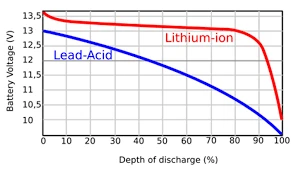SOC (State of Charge) is a core parameter in lithium battery management, directly impacting battery performance and lifespan. This article provides professional SOC estimation methods and practical reference charts.
1. SOC Definition and Importance
SOC Definition: The percentage of the current remaining charge compared to the rated capacity of the battery.
Application Scenarios:
- Estimating electric vehicle driving range
- Managing energy storage system capacity
- Assessing battery health status (SOH)
2. Standard SOC-Voltage Reference Chart (at 25°C
| SOC (%) | NMC Ternary Lithium (V) | LiFePO4 (V) | Notes |
|---|---|---|---|
| 100% | 4.20 | 3.65 | Fully charged cutoff voltage |
| 90% | 4.10 | 3.50 | Recommended daily use upper limit |
| 80% | 4.00 | 3.45 | Best operating range |
| 50% | 3.70 | 3.30 | Nominal voltage point |
| 20% | 3.50 | 3.00 | Low battery warning |
| 10% | 3.30 | 2.80 | Discharge cutoff voltage |
| 0% | 3.00 | 2.50 | Deep discharge protection point |

Note:
- Temperature changes of 10°C can shift voltage by approximately 15-30mV.
- Different manufacturers' battery parameters may have a ±0.05V variation.
3. Four Major Factors Affecting SOC Accuracy
-
Temperature Effect:
- Low temperature (<10°C): Voltage appears higher, resulting in a higher SOC estimate.
- High temperature (>40°C): Voltage decreases, resulting in a lower SOC estimate.
-
Battery Aging:
- Capacity loss leads to a decrease in the full charge voltage.
- Increased internal resistance causes voltage fluctuations.
-
Charge/Discharge Rate:
- High current discharge leads to a noticeable voltage drop.
- It’s recommended to measure the voltage at a resting state with a rate under 0.2C.
-
Battery Consistency:
- Multi-series battery packs need to account for cell-to-cell variation.
- Regular balancing maintenance is recommended.
4. Comparison of 3 Main SOC Estimation Methods
| Method | Accuracy | Cost | Applicable Scenarios |
|---|---|---|---|
| Open-Circuit Voltage | ±5% | Low | Requires resting for over 2 hours |
| Coulomb Counting | ±3% | Medium | Real-time monitoring |
| Kalman Filtering | ±1% | High | Electric vehicles/BMS systems |
Professional Advice:
- Energy Storage Systems: Use a combination of the Voltage Method and Coulomb Counting.
- Power Batteries: Must be equipped with Kalman Filtering algorithms.
5. Best Practices for SOC Management
-
Calibration Cycle:
- Perform a full charge-discharge cycle once a month.
- Conduct capacity testing once per quarter.
-
Usage Recommendations:
- Keep the SOC range between 20%-80% for daily use.
- For long-term storage, maintain 50% SOC.
-
BMS Settings:
- Charging Cutoff: Set to 95% SOC (to extend battery life).
- Discharge Protection: Set to 20% SOC (to prevent over-discharge).
FAQ
Q1: What is the difference between SOC and SOH?
SOC represents the current state of charge, while SOH (State of Health) reflects the health of the battery, usually expressed as the percentage of the current maximum capacity compared to the initial capacity.
Q2: Why does my battery show 100% SOC but the range is shorter?
This is likely due to battery aging, which causes capacity degradation (SOH decline). It's recommended to calibrate the capacity:
- Fully discharge the battery to the protection voltage.
- Rest the battery for 1 hour, then fully charge it.
- Record the actual charge amount.
Q3: How can I improve the accuracy of SOC estimation?
Recommended methods:
- Use a BMS system with temperature compensation.
- Calibrate regularly (at least once a month with a full charge-discharge cycle).
- Avoid long-term exposure to extreme temperatures.
Q4: Does SOC estimation need adjustment at different temperatures?
Yes, adjustments are necessary! Temperature compensation recommendations:
- Below 10°C: Add 3%-5% to the SOC reading.
- Above 40°C: Subtract 2%-3% from the SOC reading.
Q5: What is the best SOC for storing lithium batteries long-term?
50% SOC is recommended because:
- Fully charged batteries accelerate electrolyte decomposition.
- Fully discharged batteries may cause irreversible damage.
Q6: What could cause SOC to suddenly jump?
Possible causes:
- Imbalance between individual cells in the battery pack (more than 50mV difference).
- BMS sampling errors (check the voltage collection module).
- Voltage fluctuations due to high current charge/discharge.
Q7: How can I verify if the SOC estimation is accurate?
Verification method:
- Record the discharge process (constant current).
- Calculate the actual discharged capacity.
- Compare with the SOC displayed by the BMS.
- Acceptable error: ±3% (for high-quality BMS systems).
For more information please contact us


